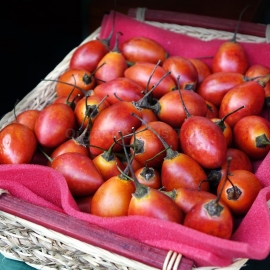 EXCLUSIVE
EXCLUSIVE






Organic Tamarillo Seeds (Cyphomandra betaceae)
7.10 €
The Tamarillo (Cyphomandra betacea) is the "Tree Tomato". Like its cousins of the closely-related Lycopersicon genus (the ordinary common tomato), the egg-size fruit makes good eating, and is typically made into jams or conserve.
-
Organic Tamarillo
The Tamarillo (Cyphomandra betacea) is the "Tree Tomato". Like its cousins of the closely-related Lycopersicon genus (the ordinary common tomato), the egg-size fruit makes good eating, and is typically made into jams or conserve, although it is recommended that the skin and seeds are removed before cooking.
It therefore makes either a fruiting shrub or a superb foliage plant! It is easily grown from seed and makes a pleasing contrast to the more typical foliage of cannas, gingers and bananas. Easily grown from seed, the roots of this plant are quite tough surviving moderate frosts, and in relatively mild areas usually re-grow from the base. Otherwise grow in a large container and overwinter frost free.
How to grow?
The tamarillo tree prefers a subtropical climate but will handle colder regions where it may shed leaves and then regrow back in spring. My mother has one of my propagated offspring in Toowoomba, which is a high altitude cold, and windy, place through winter, however, the tamarillo I gave her is growing well albeit a little slower than mine. Placed against a solid fence or wall in a cool climate for protection is the go.
Tamarillos can handle a range of soil types as long as it's not standing waterlogged for long periods. Best results come from free draining, fertile soil with a good helping of compost and manure dug in. Mulching is essential to keep the plants roots cool and protect from becoming too dry.
If the soil is heavy then build up a mound of good soil mix at least a foot high (30 cm) and 3 feet (1 x metre) wide and plant the tamarillo centrally. This method should keep its roots from becoming too wet for prolonged periods.
I've found the trees benefit from a seaweed application a few times a year, a top dressing of manure or blood and bone once a year, and a few handfuls of lime sprinkled around the base occasionally and at planting time helps keep the plant healthy.
Just like tomatoes, the tamarillo grows easily from seed and seem to be true-to-type in my experience but I have read some aren’t. I grew mine by seed from a commercial fruit I purchased and I'm happy with the dozen or so the trees it produced.
Scrape the seed out of the fruit, dry the seed first on kitchen paper towel, and then place in a propagation tray or punnet with a good seed raising mix and you should have seedlings in about a 7 days. When the seedlings are about three inches high pot-up into larger containers and as it grows continue to pot-up as appropriate.
Cuttings are another easy way to make babies off this plant and it's just a matter of using healthy pruned wood about 12 months old trimming to to about 12 inches, giving it a little hormone powder and nursing it in a pot or the ground as per other cuttings.
